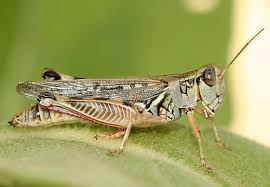Grasshoppers In the 1870s: Blessings in Disguise
Kossuth county, Iowa
The Rocky Mountain Locusts that descended on northwestern Iowa in 1873 and reappeared through most of the 1870s are the subject of stories the Peoples’ Weather Map tells about Lyon and other counties of the state’s northwest corner. Although Kossuth County has a similar story to tell of the devastation wrought by those grasshoppers that first darkened the skies in 1873, the county’s first historian, B. F. Reed, adds some details to the story that teach us more about how humans and natural hazards have interacted.
Settlers in Kossuth County, like those further west, faced financial ruin because of the damage done by the locusts, especially because they destroyed several years’ crops in succession. But being near the eastern edge of the locusts’ invasion, Kossuth County’s early settlers found some skepticism when they told their locust story to their settler neighbors to the east. Not having seen the swarms of Rocky Mountain Locusts themselves, people in Mason City didn’t believe grasshoppers could engage in extended flight.
The insects themselves were not the only unusual sight to behold in Kossuth County in the 1870s. “Notwithstanding the hard times that were brought on by the grasshopper invasion, more women appeared on the streets in silk dresses, on Saturdays during that period, than have ever been noticed since that time. As strange as this may seem to some, there was a forced reason for this singular display of silk gowns during those distressing days. The women had worn their calico dresses to shreds and were too poor to buy new ones. Each, however, had an old silk dress of which she had become possessed in by-gone days, perhaps a part of her wedding attire which she had laid away as a relic of the past. It was dug out of the bottom of the trunk and brought forth to answer the purpose of a go-to-town dress. Those seen on the streets were of a great variety of old styles, but all presenting the folding creases in the flounces, tucks, frills, yokes, pleats ruffles, shirred skirts, big sleeves, tight sleeves, long sleeves, short sleeves, full skirts, scant skirts, pointed waists, low necks, high necks, square necks and no necks—all were in evidence when the grasshopper eggs came to town as the only trading property that could be found.”
Writing in 1912, historian Reed suggests that the grasshopper invasion, especially the first in 1873, was a blessing in disguise because it taught farmers not to rely on a few crops to meet their financial obligations and support their families. After the grasshoppers destroyed what crops early farmers had put in the ground, more “attention was paid to making butter for the market” and “grading up herds.” Following the scourge of locusts there was a “right-about- face in the methods of farming. More became interested in cheese factories, butter making and in selling cream. More cows were kept, herds were improved in quality and other farm animals increased and were better cared for. In a few years a marked change throughout the country was noticeable.” Reed applauds this change and notes that afterwards farmers had something to sell besides grains, could pay their expenses, and even acquired what he calls “fat” bank accounts.
This interest in dairy farming is in evidence some decades later at the Kossuth County Centennial parade in 1954. The dairy section of the parade included fifteen floats, so many that the county’s dairy farmers issued a small brochure prior to the parade alerting visitors to the numbers and tableaux of their floats. By the end of the twentieth century when Titonka issued a book celebrating the centennial of that town, “farming operations had again reverted to grain farming for the most part.”

Sources: SHSI: B.F.Reed, History of Kossuth County, 1912; Kossuth County vertical file; The Whistle Blows at Noon: Centennial History of Titonka, 1898-1998.
